Read Also - Importance of LME Data in Metals Trading
Understanding and Trading with LME Inventory Data
The London Metal Exchange (LME) inventory data is a crucial indicator for the supply and demand dynamics of base metals. By interpreting this data effectively, traders can make informed decisions about buying or selling these metals.
Interpreting LME Inventory Data
LME inventory data is released daily and provides information on the total amount of each metal stored in warehouses approved by the LME. This data can be interpreted as follows:
Positive inventory change: An increase in inventory suggests that there is more supply than demand for the metal, which could put downward pressure on prices.
Negative inventory change: A decrease in inventory indicates that demand is outpacing supply, which could lead to higher prices.
The magnitude of the inventory change also influences the market reaction. A significant change is more likely to have a noticeable impact on prices compared to a minor change.
Factors Affecting Market Reaction to Inventory Data
The market's response to LME inventory data is influenced by several factors, including:
Inventory forecasts: Analysts forecast inventory levels before the actual data release. If the actual data deviates significantly from the forecast, it can trigger sharp price movements.
Overall market sentiment: The prevailing market sentiment, whether bullish or bearish, can amplify or dampen the impact of inventory data.
News and events: Other market-relevant news and events can influence the market's interpretation of inventory data.
Trading with LME Inventory Data
Traders can incorporate LME inventory data into their trading strategies in various ways:
Trend following: Inventory data can be used to identify trends in supply and demand. Traders can follow these trends by buying metals when inventories are low and selling when inventories are high.
Mean reversion: Inventory data can also be used to identify mean reversion opportunities. Traders can buy metals when inventories are below their average level and sell when inventories are above their average level.
Arbitrage: Traders can exploit price discrepancies between futures contracts and the underlying metal based on inventory data.
LME Inventory Data Release Time in India
The LME inventory data for base metals is released at 1:30 PM IST (India Standard Time) from Monday to Friday. However, during Daylight Saving Time in the UK (March to October), the data is released at 2:30 PM IST.
Conclusion
LME inventory data is a valuable tool for traders to gauge supply and demand dynamics and make informed trading decisions. By understanding the factors that affect the market's reaction to inventory data, traders can effectively incorporate this information into their strategies.
How to interpret and trade with LME inventory data?
Let's assume the LME Inventory:
Copper +350, Aluminum -4625, Nickel -339, Zinc +2450, Lead -850
Q: Can anyone help me make sense of this data. From what I have noticed, at times stock reacts sharply to data (i.e. movement as soon as data is released) but quite a few times the data has had no impact on the price (at least on the intraday basis).
How do I interpret LME inventory data?
Ans: Before the actual data is out, there is a forecast of what the inventory level might be. This forecast is done by analysts. If the Actual data is ahead of the forecast or below it, then there is a sharp movement in the commodity price. If the Actual data comes up close to the expected figure, the movement is very minimal.
For Example :
Let's assume the Copper inventory forecast is -350; the actual report comes as +350. Interpretation = there is more inventory than expected. "more stock than demand"...In this scenario, the Copper price would react sharply on the downside
LME Inventory Data
☼ LME Aluminium Inventory
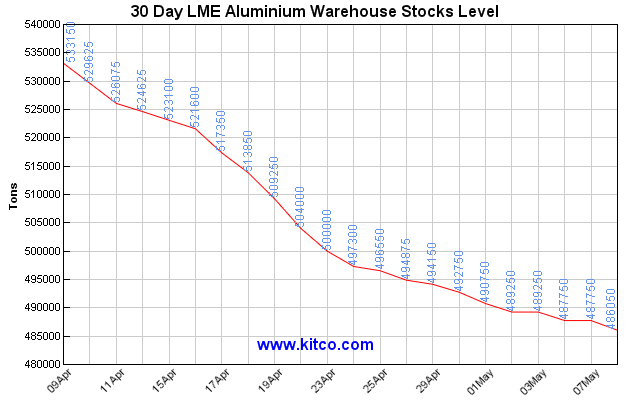
LME Aluminium Inventory
☼ LME Copper Inventory
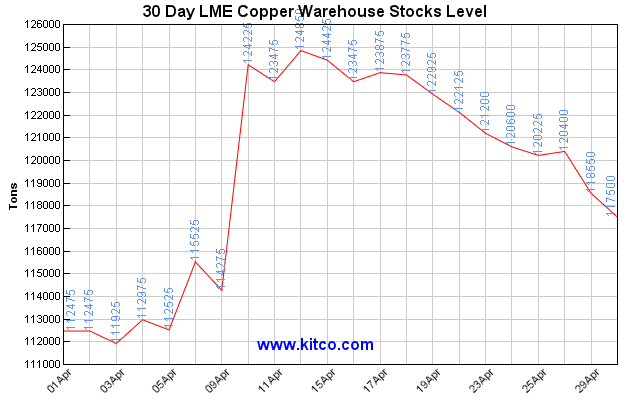
LME Copper Inventory
☼ LME Lead Inventory
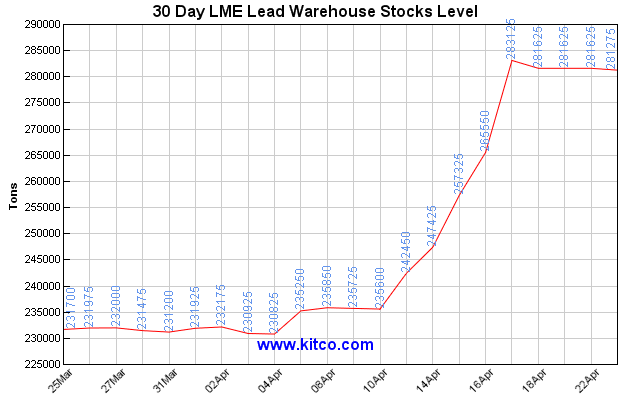
LME Lead Inventory
☼ LME Nickel Inventory
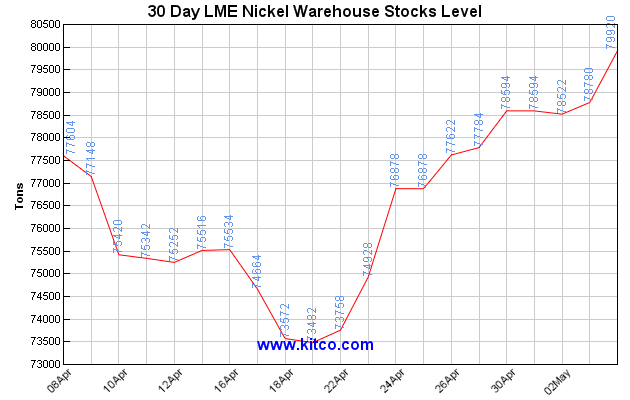
LME Nickel Inventory
☼ LME Zinc Inventory
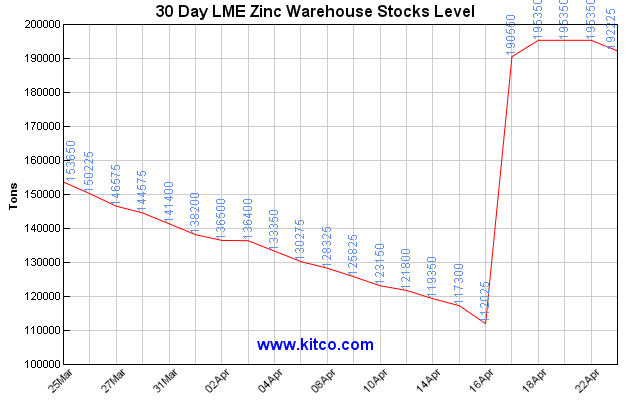
LME Zinc Inventory
☼ The following Supply and Demand Laws are necessary to understand LME inventory
Supply and demand is perhaps one of the most fundamental concepts of economics and it is the backbone of a market economy. Demand refers to how much (quantity) of a product or service is desired by buyers. The quantity demanded is the amount of a product people are willing to buy at a certain price; the relationship between price and quantity demanded is known as the demand relationship. Supply represents how much the market can offer. The quantity supplied refers to the amount of a certain good producers are willing to supply when receiving a certain price. The correlation between price and how much of a good or service is supplied to the market is known as the supply relationship. Price, therefore, is a reflection of supply and demand.
The relationship between demand and supply underlie the forces behind the allocation of resources. In market economy theories, demand and supply theory will allocate resources in the most efficient way possible. How? Let us take a closer look at the law of demand and the law of supply.
A. The Law of Demand
The law of demand states that, if all other factors remain equal, the higher the price of a good, the less people will demand that good. In other words, the higher the price, the lower the quantity demanded. The amount of a good that buyers purchase at a higher price is less because as the price of a good goes up, so does the opportunity cost of buying that good. As a result, people will naturally avoid buying a product that will force them to forgo the consumption of something else they value more. The chart below shows that the curve is a downward slope.
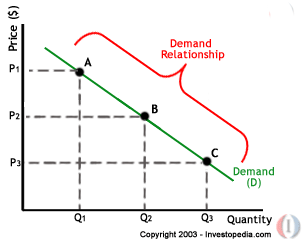 |
A, B and C are points on the demand curve. Each point on the curve reflects a direct correlation between quantity demanded (Q) and price (P). So, at point A, the quantity demanded will be Q1 and the price will be P1, and so on. The demand relationship curve illustrates the negative relationship between price and quantity demanded. The higher the price of a good the lower the quantity demanded (A), and the lower the price, the more the good will be in demand (C).
B. The Law of Supply
Like the law of demand, the law of supply demonstrates the quantities that will be sold at a certain price. But unlike the law of demand, the supply relationship shows an upward slope. This means that the higher the price, the higher the quantity supplied. Producers supply more at a higher price because selling a higher quantity at a higher price increases revenue.
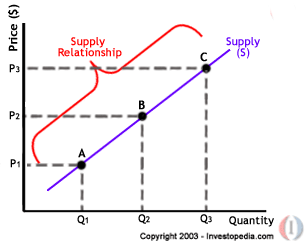 |
A, B and C are points on the supply curve. Each point on the curve reflects a direct correlation between quantity supplied (Q) and price (P). At point B, the quantity supplied will be Q2 and the price will be P2, and so on. (To learn how economic factors are used in currency trading, read Forex Walkthrough: Economics.)
Time and Supply
Unlike the demand relationship, however, the supply relationship is a factor of time. Time is important to supply because suppliers must, but cannot always, react quickly to a change in demand or price. So it is important to try and determine whether a price change that is caused by demand will be temporary or permanent.
Unlike the demand relationship, however, the supply relationship is a factor of time. Time is important to supply because suppliers must, but cannot always, react quickly to a change in demand or price. So it is important to try and determine whether a price change that is caused by demand will be temporary or permanent.
Let’s say there’s a sudden increase in the demand and price for umbrellas in an unexpected rainy season; suppliers may simply accommodate demand by using their production equipment more intensively. If, however, there is a climate change, and the population will need umbrellas year-round, the change in demand and price will be expected to be long term; suppliers will have to change their equipment and production facilities in order to meet the long-term levels of demand.
C. Supply and Demand Relationship
Now that we know the laws of supply and demand, let’s turn to an example to show how supply and demand affect price.
Imagine that a special edition CD of your favorite band is released for $20. Because the record company’s previous analysis showed that consumers will not demand CDs at a price higher than $20, only ten CDs were released because the opportunity cost is too high for suppliers to produce more. If, however, the ten CDs are demanded by 20 people, the price will subsequently rise because, according to the demand relationship, as demand increases, so does the price. Consequently, the rise in price should prompt more CDs to be supplied as the supply relationship shows that the higher the price, the higher the quantity supplied.
If, however, there are 30 CDs produced and demand is still at 20, the price will not be pushed up because the supply more than accommodates demand. In fact after the 20 consumers have been satisfied with their CD purchases, the price of the leftover CDs may drop as CD producers attempt to sell the remaining ten CDs. The lower price will then make the CD more available to people who had previously decided that the opportunity cost of buying the CD at $20 was too high.
D. Equilibrium
When supply and demand are equal (i.e. when the supply function and demand function intersect) the economy is said to be at equilibrium. At this point, the allocation of goods is at its most efficient because the amount of goods being supplied is exactly the same as the amount of goods being demanded. Thus, everyone (individuals, firms, or countries) is satisfied with the current economic condition. At the given price, suppliers are selling all the goods that they have produced and consumers are getting all the goods that they are demanding.
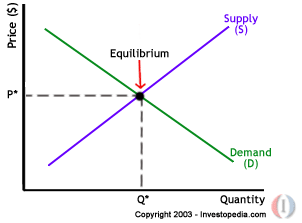 |
As you can see on the chart, equilibrium occurs at the intersection of the demand and supply curve, which indicates no allocative inefficiency. At this point, the price of the goods will be P* and the quantity will be Q*. These figures are referred to as equilibrium price and quantity.
In the real market place equilibrium can only ever be reached in theory, so the prices of goods and services are constantly changing in relation to fluctuations in demand and supply.
E. Disequilibrium
Disequilibrium occurs whenever the price or quantity is not equal to P* or Q*.
1. Excess Supply
If the price is set too high, excess supply will be created within the economy and there will be allocative inefficiency.
If the price is set too high, excess supply will be created within the economy and there will be allocative inefficiency.
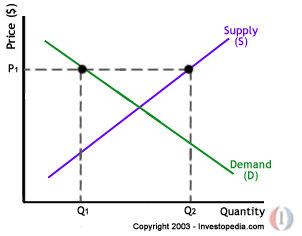 |
At price P1 the quantity of goods that the producers wish to supply is indicated by Q2. At P1, however, the quantity that the consumers want to consume is at Q1, a quantity much less than Q2. Because Q2 is greater than Q1, too much is being produced and too little is being consumed. The suppliers are trying to produce more goods, which they hope to sell to increase profits, but those consuming the goods will find the product less attractive and purchase less because the price is too high.
2. Excess Demand
Excess demand is created when price is set below the equilibrium price. Because the price is so low, too many consumers want the good while producers are not making enough of it.
Excess demand is created when price is set below the equilibrium price. Because the price is so low, too many consumers want the good while producers are not making enough of it.
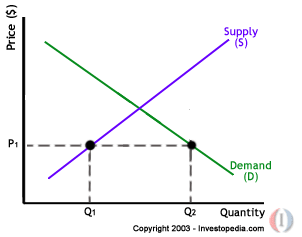 |
In this situation, at price P1, the quantity of goods demanded by consumers at this price is Q2. Conversely, the quantity of goods that producers are willing to produce at this price is Q1. Thus, there are too few goods being produced to satisfy the wants (demand) of the consumers. However, as consumers have to compete with one other to buy the good at this price, the demand will push the price up, making suppliers want to supply more and bringing the price closer to its equilibrium.
F. Shifts vs. Movement
For economics, the “movements” and “shifts” in relation to the supply and demand curves represent very different market phenomena:
1. Movements
A movement refers to a change along a curve. On the demand curve, a movement denotes a change in both price and quantity demanded from one point to another on the curve. The movement implies that the demand relationship remains consistent. Therefore, a movement along the demand curve will occur when the price of the good changes and the quantity demanded changes in accordance to the original demand relationship. In other words, a movement occurs when a change in the quantity demanded is caused only by a change in price, and vice versa.
A movement refers to a change along a curve. On the demand curve, a movement denotes a change in both price and quantity demanded from one point to another on the curve. The movement implies that the demand relationship remains consistent. Therefore, a movement along the demand curve will occur when the price of the good changes and the quantity demanded changes in accordance to the original demand relationship. In other words, a movement occurs when a change in the quantity demanded is caused only by a change in price, and vice versa.
 |
Like a movement along the demand curve, a movement along the supply curve means that the supply relationship remains consistent. Therefore, a movement along the supply curve will occur when the price of the good changes and the quantity supplied changes in accordance to the original supply relationship. In other words, a movement occurs when a change in quantity supplied is caused only by a change in price, and vice versa.
 |
2. Shifts
A shift in a demand or supply curve occurs when a good’s quantity demanded or supplied changes even though price remains the same. For instance, if the price for a bottle of beer was $2 and the quantity of beer demanded increased from Q1 to Q2, then there would be a shift in the demand for beer. Shifts in the demand curve imply that the original demand relationship has changed, meaning that quantity demand is affected by a factor other than price. A shift in the demand relationship would occur if, for instance, beer suddenly became the only type of alcohol available for consumption.
A shift in a demand or supply curve occurs when a good’s quantity demanded or supplied changes even though price remains the same. For instance, if the price for a bottle of beer was $2 and the quantity of beer demanded increased from Q1 to Q2, then there would be a shift in the demand for beer. Shifts in the demand curve imply that the original demand relationship has changed, meaning that quantity demand is affected by a factor other than price. A shift in the demand relationship would occur if, for instance, beer suddenly became the only type of alcohol available for consumption.
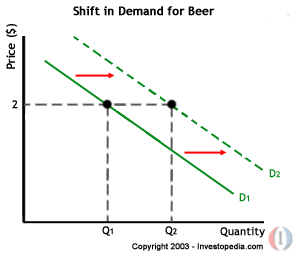 |
Conversely, if the price for a bottle of beer was $2 and the quantity supplied decreased from Q1 to Q2, then there would be a shift in the supply of beer. Like a shift in the demand curve, a shift in the supply curve implies that the original supply curve has changed, meaning that the quantity supplied is effected by a factor other than price. A shift in the supply curve would occur if, for instance, a natural disaster caused a mass shortage of hops; beer manufacturers would be forced to supply less beer for the same price.
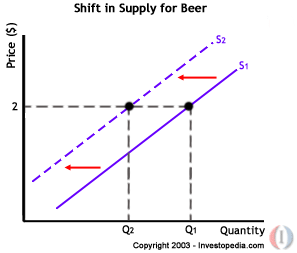 |
Source – https://www.investopedia.com/
